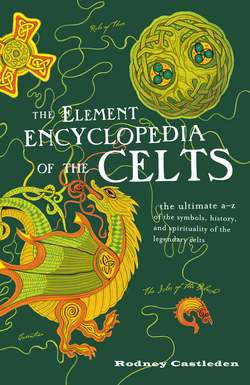Читать книгу The Element Encyclopedia of the Celts - Rodney Castleden - Страница 36
DID HE REALLY EXIST?
ОглавлениеThere are two certain dated references to Arthur in the Easter Annals, which show that he existed as a prominent historical figure:
516: Battle of Badon, in which Arthur carried the cross of our lord Jesus Christ on his shoulders for three days and three nights, and the British were victors.
537: Strife of Camlann, in which Arthur and Medraut perished [or fell].
There are various scraps of evidence of his celebrity as warrior and war leader, for instance in The Gododdin (a series of elegies) a warrior is compared unfavorably with Arthur—he fought well, though “he was no Arthur.”
The inscriptions on scattered stone memorials created in the sixth century are consistent in content and date with genealogies and other documents that we only have in copies written down much later. In other words, some of the later documents are corroborated by evidence dating from Arthur’s time. A pedigree from Pembrokeshire running to 31 generations mentions a prince named Arthur who lived in the later sixth century and was probably born around 550, just about the time of Arthur’s death according to the Easter Annals. It is possible that the child was named in memory of the king who had recently died.
An argument against Arthur’s existence is that he is not mentioned in The Ruin of Britain by the monk Gildas, written in about 540. “The silence of Gildas” can be explained fairly easily. First, Arthur was so well known by Britons living in the mid-sixth century that they didn’t need Gildas to explain who he was. Secondly, Gildas refers to kings obliquely, by nickname. Contemporary readers would have known exactly who he meant, even if we don’t, and it was his contemporaries Gildas was addressing. But Gildas describes a king called Cuneglasus as “the Bear’s charioteer.” The identity of the Bear is not immediately obvious to us, but Gildas played word games with the names of other kings, referring, for example, to Cynan or Conan as Caninus, the Dog. “The Bear” in Welsh is Arth, which brings us equally close to the name of Arthur. King Cuneglasus might as a young princeling 20 years earlier have served in Arthur’s army, and he might have been given the privileged position of driving Arthur’s chariot. So, Arthur does appear to be mentioned by Gildas after all, even if in disguise.
Some of those scholars who believe that Arthur did not exist argue their case on something very close to conspiracy theory. They begin from the presupposition that he never existed, therefore all the references to him, even in otherwise authentic documents, must be unhistorical, later interpolations, anachronistic intrusions, and corruptions of the text. Once a decision is made that Arthur cannot have existed, any evidence that he did exist must be fake. This is not so far from the conspiracy theory about the Apollo moon landings, which some people like to see as an elaborate hoax. The more evidence that is brought forward to show that the flights to the moon really happened, the more elaborate and cunning it proves the hoax to be.
We could contrast the historic Arthur and the mythic Fionn. Fionn is alleged to have fought with Vikings, but he died in AD 283, which is too early for him to have encountered them. Conversely, the Easter Annals strongly imply that Arthur fought his major campaign against the Saxons in the sixth century, between the Battle of Badon in 516 and the Battle of Camlann in 537, which is exactly the right time—according to the archeology—for him to have been doing that on the eastern boundary of Dumnonia.
